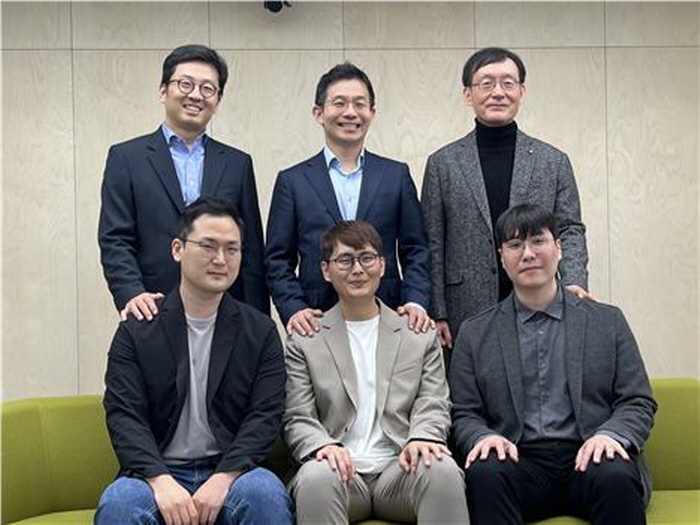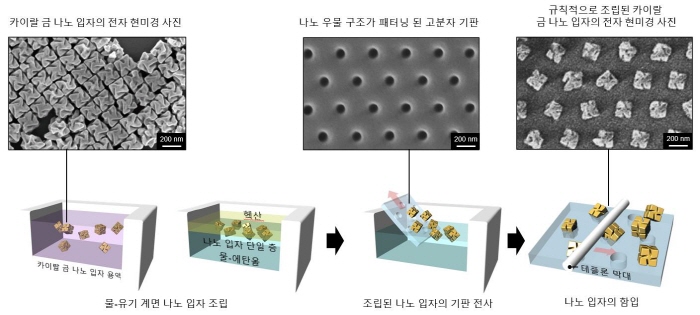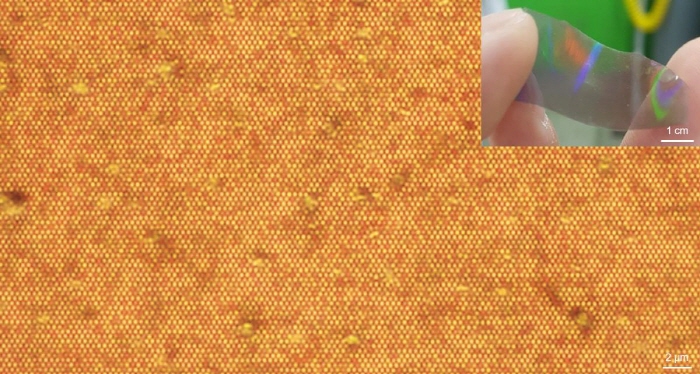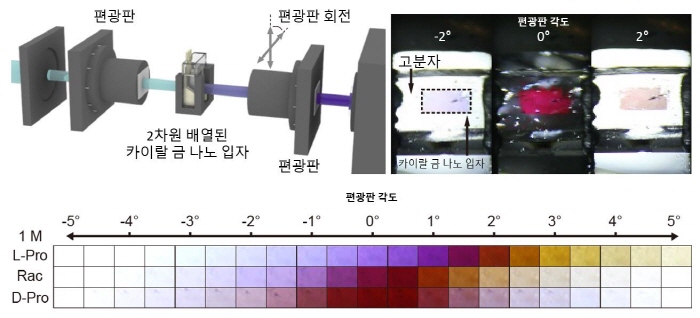Development of a Technology for Measuring the Chirality of Ultrasensitive Molecules
An important academic step in the field of next-generation matter analysis and material synthesis
The results obtained by the research group of Professors Park Q-Han and Lee Seung-woo through a joint study with a Seoul National University research group were published in Nature.

[Picture] KU-Seoul National University Joint Research Group
(From top left to right) The corresponding authors who led the research: Professor Lee Seung-woo (Department of Integrative Energy Engineering at the KU/KU-KIST Graduate School of Converging Science and Technology), Professor Nam Ki-tae (Department of Materials Science & Engineering at Seoul National University), and Professor Park Q-Han (Department of Physics at KU) and (from bottom left to right) Professor Yoo Seok-jae (first author, Department of Physics at Inha University, graduated with a doctorate from KU), Kim Ryeong-myeong (Department of Materials Science & Engineering at Seoul National University), and Huh Ji-hyeok (Research professor of the KU-KIST Graduate School of Converging science and technology)
The joint research group of Professor Park Q-Han and Professor Lee Seung-woo of KU and Professor Nam Ki-tae of Seoul National University discovered a new physical phenomenon in regard to chiral nanoparticle-based light-matter interactions and successfully applied it to biomolecules and the analysis of their chirality.
* Chirality: A characteristic of mirror symmetric structures that cannot be superimposed, like that of the right and left hands which have the same solid structure, but the left-hand glove will not fit the right hand.
This study was supported by the Creative Materials Discovery Program financed by the Ministry of Science and ICT to develop novel materials for realizing new properties and functions by utilizing new research methodologies (computational science, etc.). The results of the study were published in Nature (IF 69.504) on December 15, 2022.
* Title of article : Enantioselective sensing by collective circular dichroism / Nature
* Authors : Ryeong Myeong Kim (first author), Ji-Hyeok Huh (first author), SeokJae Yoo (first author), Tae Gyun Kim, Changwon Kim, Hyeohn Kim, Jeong Hyun Han, Nam Heon Cho, Yae-Chan Lim, Sang Won Im, Eun Ji Im, Jae Ryeol Jeong, Min Hyung Lee, Tae-Young Yoon, Ho-Young Lee, and Q-Han Park (corresponding authors), Seungwoo Lee (corresponding author), and Ki Tae Nam (corresponding author).
All living things in nature have specific interactions with light according to their structures and the materials that constitute them. The research group conducted a study on the circularly polarized light-specific interactions of molecules possessing chirality, which is one type of light-matter interaction according to the structural characteristics of various biomolecules.
* Polarized light refers to the light in which the vibrational direction (e.g., the up-and-down motion of a sea wave) of a traveling electromagnetic wave has been adjusted in a specific direction. Circularly polarized light refers to the light in which the electromagnetic wave travels while rotating circularly.
The chirality of molecules can be determined by comparing their interactions with two types of circularly polarized light that rotate in opposite directions (left circularly polarized light and right circularly polarized light). However, because the light-matter interactions are not sufficiently large due to the size inconsistency of molecules and light, the analysis requires samples of high concentration, takes a long measurement time, and is thus extremely limited.
The research group discovered a breakthrough in solving this problem from a new physical phenomenon found in the two-dimensional assembly structure of chiral gold nanoparticles. Due to their unique geometric characteristics, the chiral gold nanoparticles have a resonance with the incident circularly polarized light and may be used to efficiently control the circularly polarized light near the nanoparticles.
By introducing chiral molecules to a two-dimensional nanoparticle array, the research team successfully maximized the interactions between incident circularly polarized light and chiral molecules, achieving a chirality sensitivity that exceeds the conventional chirality detection limit. In addition, focusing on the finding that the chiral signal amplification caused by the chiral gold nanoparticle array is present in a region including visible light, the research group successfully provided a naked eye-based chirality detector that enables one to distinguish the chirality of molecules without a particular tool.
Professor Park Q-Han and Professor Lee Seung-woo of KU, the co-corresponding authors of the article, performed an electromagnetic simulation on the optical properties of the lattice of chiral gold nanoparticles, demonstrating their sensitivity to molecular chirality and establishing a novel physical theory. They said, “Our results are greatly encouraging because we were able to open a new way to chiral molecule detection through the creative convergence of biomimetic material science, engineering, and computational nano-optics. Now, we live in a new era where we can figure out the chirality of molecules with our naked eyes.”
The ultrasensitive molecular chirality analysis based on the chiral gold nanoparticle array is applicable to the analysis of various biomolecules, chemicals, and pharmaceuticals. Therefore, the new technology is expected to have significant ripple effects on not only various industries where biomaterial synthesis and analysis are important, such as analytics, diagnostics, and pharmaceutics, but also on basic sciences, such as chemistry, biology, and physics.
[ Description of Terms ]
1. Chirality
○ Chirality is a structural characteristic of biomolecules. The term chirality is used to describe a mirror image structure of molecules that cannot be superimposed. Human hands are the easiest illustration of chirality. A molecular example is molecules consisting of the same atoms but having different arrangements.
2. Polarized light
○ Light is described as an electromagnetic wave having the form of a sea wave. Polarized light refers to the light in which the vibrational direction (e.g., the up-and-down motion of a sea wave) of a traveling electromagnetic wave has been adjusted in a specific direction. Circularly polarized light refers to the light in which the electromagnetic wave travels while rotating circularly.
3. Hybridization
○ A DNA molecule binds to a pair DNA molecule that has a complementary sequence, forming a double helix. The binding process is referred to as hybridization.
4. Light-matter interaction
○ All matters in nature have specific interactions with light. For example, the green color of leaves is visible because the leaves reflect only the green color from the white light (mixture of all light colors). Light-matter interaction refers to the interaction of matter with light, including light absorption, reflection, penetration, and scattering.
[ Description of Figures ]

[Figure 1] A schematic diagram of the fabrication of the regular assembly structure of chiral gold nanoparticles.
Chiral gold nanoparticles synthesized in the state of a solution are assembled into a nanoparticle monolayer through water-organic self-assembly. The nanoparticle monolayer is then transferred onto a polymer substrate on which nano-wells are patterned, and a Teflon-coated stick is used to assemble the nanoparticles into nano-well structures. In the regular assembly structure of the chiral gold nanoparticles fabricated in this study, the chiral gold nanoparticles of 180 nm are regularly arranged in a hexagonal array with a gap of 400 nm.

[Figure 2] A dark-field microscopic image of the regular assembly structure of the chiral gold nanoparticles and a photo of an actual device.
Figure 2 shows a dark-field microscopic image of the regular assembly structure of the chiral gold nanoparticles and a photo of an actual device fabricated by using the assembly. The methodology developed by the research group allows a large-area array of the chiral gold nanoparticles. In the picture above, each of the bright points represents a single chiral gold nanoparticle. In addition, as shown in the right top of the image, the device developed by the research group can be fabricated into a large-area device several centimeters in size, which can thus be applied to practical sensor devices.

[Figure 3] Naked eye-based chirality analysis using the regular assembly structure of the chiral gold nanoparticles.
The assembly structure of the chiral gold nanoparticles prepared in this study has specific interactions with polarized light and thus exhibits different absorption characteristics depending on the light wavelength while being capable of rotating polarized light. In the established optical system, shown in the left top, when the angle of the polarized plate is changed, the wavelength-dependent light absorption of the chiral gold nanoparticles gives different colors to the incident light (right top). The research group confirmed that the polarized light-dependent absorption is dependent upon the chirality of molecules (bottom). When solutions of the same concentration of proline molecules consisting of the same atoms (L-, D-, Rac (1:1 mixture of L- and D- molecules)) were placed on the assembly structure of the chiral gold nanoparticles, the color of the polarized light changed according to the chirality of the molecules. The results demonstrated the possibility of naked eye-based chirality analysis.



